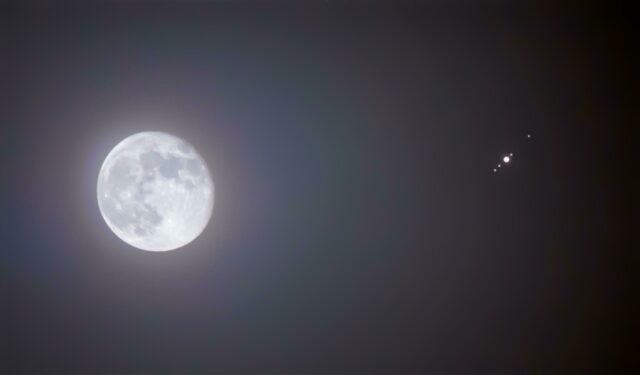Landis’ dark skies draw amateur astronomers and guests to star parties for telescopic views of celestial sights. The Meeting House deck provides a fine vantage point, even to the naked eye. It has a great view over the Schoharie Valley to the east and southeast, perfect for watching sun and moon rises.

Stargazers embrace moonless nights as dark skies reveal the stars in all their glory. Learning the sky is fun and has never been easier. Planetarium apps showing and identifying the stars, asterisms, and constellations, are widely available and inexpensive. (Casual sky watchers don’t need the bells and whistles of the expensive versions.)
I look to the eastern sky as a preview of coming attractions. The stars now in the east just after darkness falls will be high in the sky in two months.
Coming heavenly events include:
- In late March, look for Leo, the Lion, in the east just after dusk. A backwards question mark of stars outlines his head, with bright Regulus at the bottom. A triangle of stars to the lower left marks his hind quarters.
- Jupiter will dominate the spring skies. The April 10th moon, approaching full, will rise at 7:05 PM a little south of due east. Brilliant Jupiter will be just two degrees to its right – a lovely pairing.

- On April 11, the moon, just past full, will rise at 8:05 PM, and Jupiter will be 14 degrees away. In late April, look for brilliant and unmistakable Jupiter with reddish Arcturus well to its left. Arcturus is the brightest star in Boötes, the Herdsman, and stars stretching left outline a kite. By late May, Boötes will be high in the east. Look for Corona Borealis, the Northern Crown, and the butterfly shape of Hercules, the Son of Zeus, below and to its left. Watch farther to the north for bright Vega, the brightest star of the Summer Triangle, to clear the trees.
- A modest meteor show, the Lyrids, will be visible from April 16 through the 25th. The peak will be on the night of April 22 through the morning of April 23, with the best show from 1 AM until dawn. At its peak, the shower produces about 20 meteors an hour.
- During the May 26 and 27 star parties, Jupiter will be due south at its highest. A telescope reveals dark bands in its atmosphere and other details, as well as its four bright Galilean moons. By June 9, the full moon will be rise in the east-southeast at 8:34 PM, with Saturn just 2.5 degrees to its lower right.
- Night rocket launches from Wallops Island, Virginia, can sometimes be seen. At the end of our September 6, 2013 star party we stood on the Meeting House deck and watched the flight of the LADEE lunar mission atop a Minotaur rocket. First glimpse of the rocket was through the pines to the south, then it emerged into full view, moving eastward low on the horizon. Its rocket plume appeared very orange, and we watched until it moved into a bank of clouds. A great way to end our star party!
There’s more to nights at Landis than the sky. The calls of owls, usually the “Who cooks for you?” of the barred owl, often break the stillness of the night, as do the cries of coyotes. So even at night, Landis is a lovely place to enjoy the beauty of nature, away from the noise and rush of modern life.
